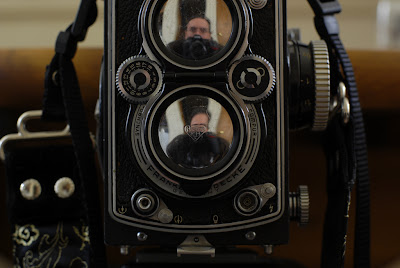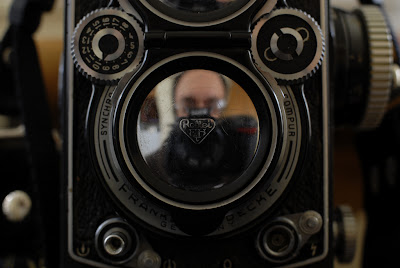If you are like me, you love taking close up photos of things. You find the close focus distance of most lenses restrictive and annoying. Maybe you are lucky and your kit lens focuses decently close (for instance, the Nikkor 18-55mm f/3.5-5.6 and 55-200mm f/4-5.6 kit lenses I started out with on my D40 both focus surprisingly close. My early dragonfly photos were all shot with the 55-200 which focuses down to about 1:3!), but at some point you will probably want to get even closer.
There are myriads of issues with real macro shooting. As you focus closer, steadying the camera becomes harder and positioning becomes touchy. VR/IS becomes less effective. Lenses also lose light and some may perform poorer at close focus distances. Focus breathing can become an issue when you try to compose. The depth of field gets thinner and trying to stop down quickly hits limits due to diffraction.
Mind you I am just a dilettante. I don't have the proper support or ring lights or bellows or focusing rails that a professional would use to overcome these issues and I have never tried focus stacking (using a program to combine shots with the camera in a fixed position but varying focus into one image with artificially deeper depth of field). But I am going to maunder on a bit about macro shooting anyway.
Your first and cheapest option is to buy a kit of close-up lenses. You can buy cheap kits with +1, +2, and +4 diopters, which will give you a fair bit of flexibility if not the best performance. I've read that you are supposed to have the lens focused at infinity and stop down to get the best results, but I would focus close and stack the lenses and still got acceptable results-for an amateur at least. Note that when a close-up lens is mounted you will have a limited focusing range only close to the camera. One other thing to look out for is that the +4 diopters have a very curved lens: I could not put a filter or lens cap over mine.
There are high-end multicoated and even multi-element close up lenses as well, but they seem like the worst of both worlds to me.
Overall, close-up lenses are a good way to get your feet wet, but they are cumbersome to switch on and off your lens to try to get the right effect.
Another relatively inexpensive option is the use of an extension tube. Although they still seem expensive for a hollow tube. Like close-up lenses, they come in various lengths with corresponding changes in magnification and can be stacked. They do loose light, and you might have to find the compensation for metering empirically. However, they are just as much as a hassle to use, plus as far as I know there are not any modern extension tubes that support autofocus or metering or flash information or VR/IS etc. Fortunately for me I mostly use AI/AI-S Nikkors which are already manual focus and Nikon made extension tubes like the PK-13 which mechanically link the aperture information. I think a dedicated extension tube might be worth considering with a specific macro lens, (like the PK-13 with the 55mm f/2.8 AI-S and the PN-11 with the 105mm f/2.8 AI-S, which allow the lenses which normally focus down to 1:2 to focus down to 1:1 or a little closer).
I guess one plus is that one extension tube will work with any lens (where as you would be limited by filter size with close-up lenses and reversing rings), although the performance might vary from lens-to-lens. I have read that lenses with close range correction in particular can be thrown off by extension tubes, (see Ken Rockwell's review of the
105mm f/2.8 AI-S (You will just have to forgive me for being tangential (and parenthetical))).
Nikon used to be so good about standardizing to a 52mm filter thread for all their reasonable consumer lenses, from the 20mm f/3.5 out to the 200mm f/4! It really bothers me they are bouncing from 52, 58, 62, 67, 72, and 77mm filter threads nowadays...Admittedly people rarely use filters except for "protective" UV filters and the occasional polarizer or ND filter since everything can be done in photoshop. I am such a luddite...
Edit: of course bellows are also an option as a sort of continuously variable extension tube. However they seem to be fairly pricey. Some even offer limited movements like a little tiny view camera, such as the
Nikon PB-4.
Close-up lenses and extension tubes both decrease working distance (the distance between the front of the lens and the subject), which can lead to you blocking the light, scaring your subject, or smashing your lens into things. In extreme/silly cases it can be completely usable, for instance I tried to put a fisheye lens on and extension tube and the focus was somewhere inside the lens.
The final relatively inexpensive option is a reversal ring, which has a male lens mount on one side and male filter threads one the other side. As the name implies, this allows you to mount a lens backwards, (potentially) turning it into a macro lens!
I must admit I know the least about these. I just found a Nikon BR2 reversal ring in a pile of loot recently. Some things I do know: mounting a lens by its filter threads does not feel very secure, even with a lens with metal filter threads. I would not try it with longer or heavier lenses. It also leaves the base of the lens exposed, which is potentially hazardous (some lenses have exposed rear elements and delicate prongs and levers). Of course you can use a rear lens cap as a normal lens cap! The reversal of the lens makes it pretty much impossible to have communication between the camera and body. The gelded Nikon lenses (with the G in the name) would be more or less worthless reversed unless you could hold the stop-down lever in the correct position, so you really need to use lenses with aperture rings, and even then it is like being in the days of preset lenses. (Edit: there are some rings which will facilitate this, like the
Nikon BR-6 when used with a double cable release). Open the lens up to focus, stop down to meter and shoot, repeat.
My understanding is that the wider the lens you attach, the larger the reproduction ratio. That is, a reversed 20mm lens will have more magnification than a reversed 24mm lens, etc. (I will have to get some more wide angle lenses and experiment! I've been wanting a 20mm for a while...)
Reversing a lens has other complications. The focusing ring will probably no longer do anything because of how most lenses move the barrel while keeping the base of the lens inert-with the lens reversed this will just move the base of the lens around without changing the optics. I wonder what happens with a rear-focusing lens (or a zoom lens, for that matter)! I don't think I have any to test it out with currently...The distance from the lens to the focus plane should be approximately the distance from the flange to the focal plane on your camera, but I will have to double check this too. In other words, the working distance will always be a couple inches, which is not great but not awful either.
I am not sure how to figure out and metering compensation for a reversal ring, but I guess just empirically. I wonder if a reversed telephoto will become a wide-angle? I will have to try it. I wish I could reverse mount a fisheye lens, but most lack filter threads.
Clearly I have some experimenting to do...
I am guessing you could kludge together extension tubes and reversal rings with some body and lens rear caps and a trashed filter, though I wouldn't trust such a contraption with any of my lenses.
That said, if you are even slightly interested in macro photography, I think it is worth spending the money on a macro lens. I would even suggest getting one in the place of a 'nifty 50' (50mm f/1.8), a 55 or 60mm f/2.8 macro lens is still two stops faster than many zoom lenses and offers a lot more flexibility. Macro lenses are also usually better corrected and made than their higher speed counterparts...Of course, a 105mm macro makes a nice portrait lens, and a 200mm macro makes a nice telephoto too, so why buy non-macro lenses?












